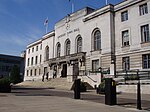Metropolitan Borough of Hackney
1900 establishments in the United Kingdom1965 disestablishments in the United KingdomDistricts abolished by the London Government Act 1963Hackney, LondonHistory of the London Borough of Hackney ... and 1 more
Metropolitan boroughs of the County of London

The Metropolitan Borough of Hackney was a Metropolitan borough of the County of London from 1900 to 1965. Its area became part of the London Borough of Hackney.
Excerpt from the Wikipedia article Metropolitan Borough of Hackney (License: CC BY-SA 3.0, Authors, Images).Metropolitan Borough of Hackney
Mare Street, London Homerton (London Borough of Hackney)
Geographical coordinates (GPS) Address Nearby Places Show on map
Geographical coordinates (GPS)
| Latitude | Longitude |
|---|---|
| N 51.5451 ° | E -0.0564 ° |
Address
Hackney Town Hall
Mare Street
E8 1EA London, Homerton (London Borough of Hackney)
England, United Kingdom
Open on Google Maps









